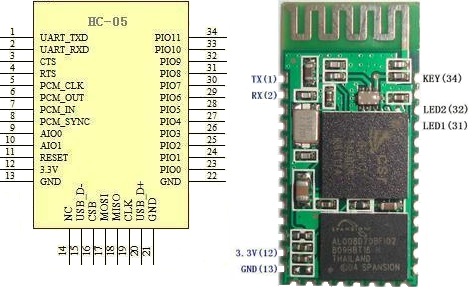When I first ordered my Bluetooth module, I got a "Bluetooth Serial Transceiver Module Base Board with Enable function For Arduino" from Ebay. I payed a few dollars for it only to realize when I got it that the board was merely a breakout (called a JY-MCU) for another board. Another purchase later, and I had all the things I needed to get going. I got an HC-06 (aka "New Mini 3.3V wireless Bluetooth Transceiver Slave Module Serial Port 30ft TTL"). There is also an HC-05 which apparently is very similar (it seems to share the same pinout).
 |
| HC-05 pinout |
 |
| My impressive soldering |
Next I wired it up. This is the point where I began calling on the collective knowledge of the internet. Follow THIS Instructable. With a few changes, it is what I did. For the voltage divider I used a 2.2k Ohm and a 1k Ohm + 100 Ohm resistor. It worked fine. I checked it with the volt meter and it came out to about 3.1v. HERE is the voltage divider calculator I used. Be sure you use that on the Bluetooth Rx/ Arduino Tx side or else you could fry your Bluetooth module. The ATmega 2560 will accept 3.3v so the Arduino Rx is fine by itself (sort of. I wouldn't put this on anything too important, but worst you will get false data). Someday I'll get a real logic level converter. For convenience, I used the Serial1 pins on my Arduino Mega 2560.
Now you need to load a test sketch onto your Arduino. I used the one on the Instructable (with Serial changed to Serial1). To do this you will probably need to unplug the Arduino Rx pin. Should we have loaded the program before wiring like the Instructable said? Probably. Oh well. Take this opportunity to double check all wiring and ring them out with a volt meter.
Now we need to connect the HC-06 Bluetooth module to the computer. I am running Windows 7, and this took about 3 minutes. The steps are on the Instructable, but I would feel bad if I didn't post all the screenshots that I took. Power up your Bluetooth module and follow the steps below.
1) Find the Bluetooth Icon in the bottom right hand portion of the screen. Right Click and Select "Add a Device." My device was called linvor. Whatever floats their Chinese boat. The password for mine was 1234. If that doesn't work, try 0000.
2) Go to Devices and Printers and see if it appears. Wait for Windows to install all necessary drivers. note what COM port it is using. Mine uses two apparently.. Oh well. Not worth the energy to worry about it.
3) Download a terminal emulator program. "Can't I just use the Serial Monitor???" No. Only one device can use a serial port at a time. That is why the Serial Monitor shuts down when you upload a sketch. "Then what should I use???" Well I used Tera Term like the Instructable said because it was the least confusing to a simple mind like me. PuTTy and RealTerm are probably more popular choices. I haven't explored them. I'll assume you use Tera Term.
4) Connect to the module in Tera Term. This is super simple. Select the right COM port.
5) Bask in the beauty of the numbers streaming by.
This took all of an hour for me. I was astonished at how painless it was, especially compared to my struggles with the nRF24L01+. I am not sure what I will do with it now (I have some ideas). I hope you all have the same success I did. If you need the sample sketches for some reason, they are HERE.
Best of luck,
-Matthew




I'm confused about the master/slave functionality.. I managed to do the same as you where Arduino sends data to the pc, but can I send data back to the module? or this is not possible in the HC06?
ReplyDeleteIt is both possible and simple. You can think of your bluetooth as a wireless USB cable. Your Arduino is still connected via serial, but instead of using USB you are using this bluetooth module. You just need a program that will write to that COM port. If you are getting data in the terminal emulator like shown above, then you just need to type something in the window and hit enter. It should send the data.
ReplyDeleteOn the Arduino side you will need to do something like a Serial.read() or Serial.parseInt(). I don't have an explicit post to refer you to. You can look at some of my other posts labeled communication. Some of them demonstrate receiving Serial data.
Hopefully that answered your question. Let me know how it goes.
I updated one of my links. I didn't realize it was broken. I also created a quick post on this topic. Maybe it will clear things up.
ReplyDeletehttp://projectsfromtech.blogspot.com/2013/09/receiving-serial-data-with-arduino.html